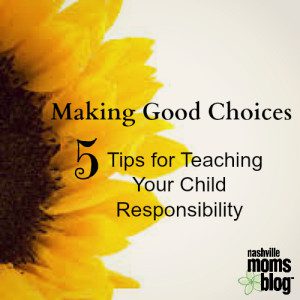Part of teaching children responsibility is teaching them to think about the impact their decisions and actions will have for themselves and others. This can include allowing your child to pick out their own outfit for school, discussing the pros and cons of dinner choices, or encouraging him pack his own suitcase for a family trip.
Opening the door to making choices means you’ll need to guide and channel your child’s natural desire for independence in a constructive way. Preschoolers are still in the process of learning about making and breaking promises, commitments, and consequences. Responsibility is an abstract concept that can’t be explained with a single example. Children come to an understanding of what it means by watching and listening to their parents and other significant role models in their lives.
Children also learn about responsibility by being given developmentally appropriate duties to fulfill like helping set the table for dinner, putting away toys, and keeping a bedroom clean. Empowering your child to make his own decisions at an early age can foster independence, self-esteem, and problem-solving skills that will be very beneficial in later years! Dr. Gloria Julius suggests the following tips for teaching children to practice responsibility and make decisions for their own lives.
Simplify the process. Offer a limited number of realistic choices by adding a little helpful information at the same time: “It’s very cold outside today. Would you rather wear your red sweater or your blue jacket?” By offering fewer options along with why those options are the choices, you and your child can share control of the end result.
Offer age-appropriate choices. Be sure to take your child’s age and developmental level into consideration when asking him to make decisions. Young children can have difficulty thinking beyond the moment when asked to respond to open-ended questions. For example, if you ask your child what he wants to eat for dinner, he may respond with “ice cream” because that is his favorite food. But by offering a choice—pasta or chicken—you are offering two healthy options.
Validate your child’s choice. Once your child has made a decision, validate it with a genuine response: “I’m glad you chose this book. It’s one of my favorites, too. It has such pretty pictures!” By affirming your child’s decision, you build her confidence to make future decisions.
Establish expectations. As adults, we know we don’t always end up making the “best” or “right” decisions, and it’s important to share this with your child. Let him know it is okay to ask for help and that it’s fine if things don’t turn out as expected. Your child should feel comfortable asking for support and not worry about failing.
Guide your child through the decision-making process. This is a great way to actively engage your child in what it means to make decisions. Think out loud with her by discussing the options. Your child can learn a lot by making a mistake or wishing she had made a different choice! For example, if your child asks to take multiple toys outside, you can respond with, “Try it and let me know how it works. That way you will know whether or not to take both outside next time.”
Sarah Shanaman is a Nashville native. She graduated from Belmont University in 2008 with a degree in Music Education. She has enjoyed working with children and aiding them in their education.
In 2010, she joined the Primrose School’s family. Sarah is excited to be the director of, and a part of the Primrose School of Nashville Midtown team.
Sarah has a wonderful husband who is originally from Pennsylvania. They became parents this year to their daughter Lyla, and are loving the journey.


















[…] 5 Tips for Teaching Your Children Responsibility at Nashville Moms Blog […]